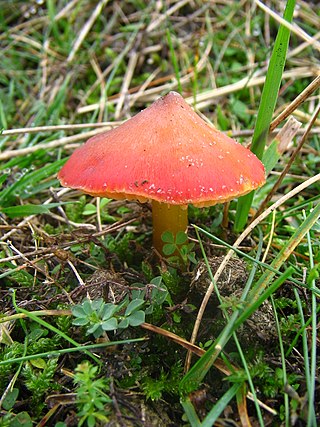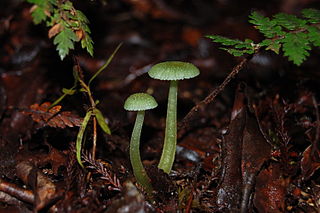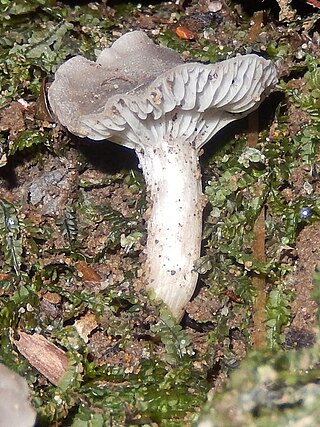
Hygrophorus is a genus of agarics in the family Hygrophoraceae. Called "woodwaxes" in the UK or "waxy caps" in North America, basidiocarps are typically fleshy, often with slimy caps and lamellae that are broadly attached to decurrent. All species are ground-dwelling and ectomycorrhizal and are typically found in woodland. Around 100 species are recognized worldwide. Fruit bodies of several species are considered edible and are sometimes offered for sale in local markets.

Hygrocybe is a genus of agarics in the family Hygrophoraceae. Called waxcaps in English, basidiocarps are often brightly coloured and have dry to waxy caps, white spores, and smooth, ringless stems. In Europe they are characteristic of old, unimproved grasslands which are a declining habitat, making many Hygrocybe species of conservation concern. Four of these waxcap-grassland species, Hygrocybe citrinovirens, H. punicea, H. spadicea, and H. splendidissima, are assessed as globally "vulnerable" on the IUCN Red List of Threatened Species. Elsewhere waxcaps are more typically found in woodlands. Most are ground-dwelling and all are believed to be biotrophs. Around 150 species are recognized worldwide. Fruit bodies of several Hygrocybe species are considered edible and are sometimes offered for sale in local markets.

Hygrocybe conica is a species of agaric in the family Hygrophoraceae. In the UK it has been given the recommended English name of blackening waxcap, since all parts of the basidiocarp blacken with age. In North America it is commonly known as the witch's hat, conical wax cap or conical slimy cap. Hygrocybe conica is known to be a complex of at least eleven closely related species and as such is widespread in Europe, North America, Asia, and elsewhere.
Anthony "Tony" M. Young is an Australian mycologist based in Queensland, affiliated with the University of Queensland. He has published several books on fungi as well as a monograph on Australian Hygrophoraceae, resulting from his research on Hygrocybe and related genera. In 2007, he was a co-author of a review of the genus Ramaria in Australia, a work in progress which will see the likely description of 15 new Australian species and increase the total number to 50.

Hygrocybe aurantipes is a gilled fungus of the waxcap family found in a few scattered locations in wet forests in eastern Australia. It is a distinctive small mushroom with a 2–4 cm diameter olive-brown cap and golden-yellow stipe and gills, not easily confused with any other species. Known only from Lane Cove Bushland Park in Sydney's suburban Lower North Shore, Hazelbrook and Mount Wilson in the Blue Mountains, it has been designated as vulnerable as defined by the NSW Biodiversity Conservation Act 2016, by the New South Wales Government.

Hygrocybe austropratensis is a gilled fungus of the waxcap family found in a few scattered locations in dry sclerophyll forests in eastern Australia. It is a small mushroom with a 1.4–3 cm diameter pale orange or orange-brown cap and buff-coloured stipe and gills. It is known only from near Sydney, Hazelbrook in the Blue Mountains, and Victoria.

Hygrocybe anomala is a mushroom of the waxcap genus Hygrocybe. Known from Australia, it was first described scientifically by A.M. Young in 1997.

Hygrocybe lanecovensis is an Australian mushroom of the waxcap genus Hygrocybe. An endangered species, it is found only at Lane Cove Bushland Park in suburban Sydney.
Hygrocybe kula is a mushroom of the waxcap genus Hygrocybe found only in Royal National Park and Lane Cove Bushland Park. It was described in 1997 by mycologist Cheryl Grgurinovic.

Hygrocybe cantharellus, commonly known as chanterelle waxy cap, is an agaric in the family Hygrophoraceae. It is found in eastern North America and Australia. The European Hygrocybe lepida was previously referred to this name, but is now known to be distinct.

Hygrocybe astatogala is a mushroom of the waxcap genus Hygrocybe. It is found in Madagascar, Australia, Central Africa, the Philippines and New Zealand, it was first described scientifically as Bertrandia astatogala by French mycologist Roger Heim in 1936. Paul Heinemann transferred it to Hygrocybe in 1963.

Gliophorus graminicolor is a species of agaric fungus in the family Hygrophoraceae. It is found in Australia and New Zealand. In 1995, Australian mycologists Tom May and Alec Wood transferred the species to Hygrocybe, but the taxonomic authority Index Fungorum retains it in Gliophorus.
Hygrocybe fuhreri is a mushroom of the waxcap genus Hygrocybe. Described by mycologist Anthony M. Young in 2000, it is found in Australia, where it grows in moss and leaf litter in eucalypt woodland.
Hygrocybe saltirivula is a mushroom of the waxcap genus Hygrocybe. Described by mycologist Anthony M. Young in 2000, it is found in Australia, where it grows in deep moss in eucalypt woodland.
Gliophorus pseudograminicolor is a species of agaric fungus in the family Hygrophoraceae. Found in Australia, it was originally described in 1997 by mycologist Anthony M. Young as a species of Hygrocybe and transferred to Gliophorus in 2013.

Hygrocybe griseoramosa is a mushroom of the waxcap genus Hygrocybe. It is grey or fawn in colour, and generally grows in moist, shady conditions. A rare species, it is only found near Sydney. Also this species has been found growing in Tasmania. It was described in 2001 by the mycologist Anthony M. Young.

Hygrocybe bolensis is a mushroom of the waxcap genus Hygrocybe. Generally found growing in soil in moist, shady conditions. It was described in 2000 by the mycologist Anthony M. Young.

Hygrocybe collucera is a mushroom of the waxcap genus Hygrocybe. It grows in moist, shady conditions. A rare species, it is only found near Sydney. It was described in 2001 by the mycologist Anthony M. Young.

Hygrocybe erythrocala is a mushroom of the waxcap genus Hygrocybe. It grows in moist, shady conditions near Sydney, Australia. The cap is viscid and glossy with striations; this species lacks decurrent gills. It was described in 1997 by the mycologist Anthony M. Young.














